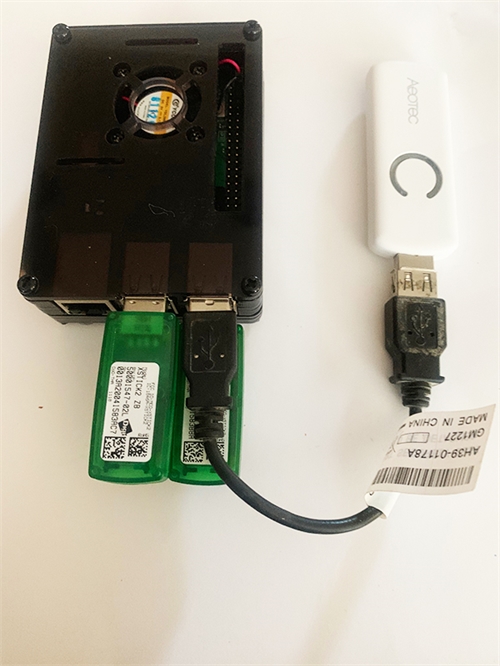Preparation for Beta Testing
These notes contain answers to questions that have been raised by potential Beta testers.
The Hub
The hub is assembled from a set of standard parts, which you will need to purchase.
The core of the hub is a Raspberry Pi 3B or 3B+, for which you will also need an enclosure and a power supply / charger.
Network Adapters
To get started with the 1st generation Iris devices, you only need one USB network adapter, which plugs directly into the Pi. This should be a Digi XStick XU-Z11 ZigBee adapter.

When you want to extend the system to include 2nd generation Iris devices, other modern ZigBee HA devices, Z-Wave devices, etc., you will need:
A second Digi XStick XU-Z11 adapter for the ZigBee devices, and
An Aeotec ZW090 adapter for the Z-Wave devices.
Modified March 25th, 2019
We had recommended the use of a USB hub to connect the network adapters to the Pi, because the spacing between the USB ports on the Pi prevented more than two adapters being connected to it.
There do seem to be some issues with the USB hubs, so we have adopted the suggestion made by RonLH, as shown in the image, which is to insert the two XSticks directly into the Pi, and to use a very short cable for the ZStick
Hardware Suppliers
You can purchase the Digi XStick XU-Z11 online from https://www.digikey.com, # 602-1144-ND, or from https://www.mouser.com, # 888-XU-Z11.
You can purchase the rest of the items from Amazon, which are:
- Raspberry Pi 3 B+
- NorthPada Raspberry Pi 3 Model B B+ A+ Plus Power Supply / Charger
- iUniker Raspberry Pi 3 B+ Case
- 4 inch (10 cm) USB Cable
- Aeotec Z-Stick Gen5, Z-Wave Plus USB
NorthPada has several products for sale on Amazon. This power supply / charger is shown as Amazon's Choice at $9.99 plus shipping. It delivers 3 Amps at 5 Volts. Its ASIN number is B01N336XEU.
This case / enclosure includes a cooling fan, which needs to be plugged into the Pi. The instructions should be included with the case.
The Software
Modified March 4th, 2019
We had intended to supply the software preloaded on an Micro SD card. It is now available as an image for downloading and installing on your Micro SD card. We recommend a 16 GB class 10 Micro SD card, or better.
You will also need an adapter to plug your Micro SD into your computer to apply the image to the Micro SD card.
The software will be licensed for use by the Beta testers free of charge. No time limit will be placed on the retention and use of this software by these Beta testers.
The software supplied to these Beta testers will continue to be updated free of charge. This updating will be performed by downloading the update from our cloud based services.
Software Registration
The software running on the Pi will need to access our cloud based services in order to register. Once registered, the software will run standalone on the hub.
To complete the registration, the control system will need to be linked to your user account. This will be done by visiting a URL, which will be accessible from your user account on this website.
Non-disclosure / Confidentially Agreement
We would normally expect to have some form of mutual NDA when working with other organizations, but it is very difficult to frame a suitable non-disclosure or confidentiality agreement in these circumstances.
We also want to encourage dialog amongst the Beta testers, and an exchange of ideas and suggestions.
The administrators of the Living with Iris Forum have kindly set up an area on the forum specifically for the exchange of comments amongst Beta testers. Users will be given access to this area, once they have registered their software.
When the software is made more widely available, then we will require registered users to accept our terms of supply.
Support
Full support will be provided throughout the Beta testing period, again free of charge.
To assist users, we may request remote access their hub, which will allow us to operate the system as if we had direct local access to the hub. Our access to the hub is enabled and disabled by the user.
Device Profiling
Each device, such as a door or motion sensor, is profiled. This enables it to be presented as a standardized generic device type, such as a motion sensor, to the control system, rather than being manufacturer or protocol dependent. The application of a profile to each device occurs automatically when the device is added to the network.
We have profiled most of the 1st generation Iris devices, along with many others. We shall continue to profile devices throughout the Beta testing phase, and subsequently.
Some Beta testers are providing additional assistance, by enabling the data flowing with their existing system to be recorded for subsequent analysis. This exposes the respective behaviors of each device and the hub software. It provides a double-check on our profiling, and may expose additional device characteristics that are not advertised publicly.
Future Pricing
Once the Beta testing is nearing completion, prices will be quoted to other users. The price structure will be competitive, and will take into account the price structures of other offerings.
The most likely pricing structure will be a traditional one-off license price, rather than a subscription service. There may also be additional prices for software updates, support after an initial period, new networks, and new device profiles.